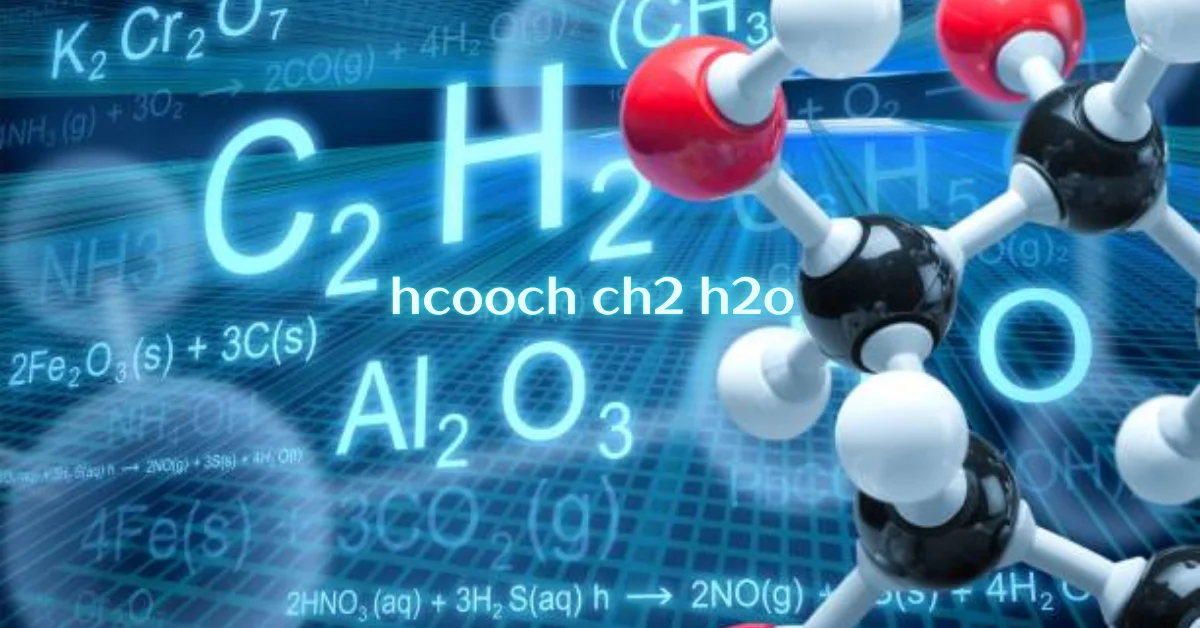Introduction to HCOOH CH2 H2O
When it comes to innovative chemistry, HCOOH CH2 H2O is making waves. This unique compound, consisting of formic acid and methanol in a water medium, offers fascinating possibilities in both laboratory settings and industrial applications. With the world’s increasing focus on sustainability, its role in green chemistry cannot be overstated. In this blog post, we’ll explore the chemical properties that make HCOOH CH2 H2O so versatile and delve into hcooch ch2 h2o lab reactions that highlight its potential. From reducing environmental impact to enhancing efficiency in manufacturing processes, join us as we uncover how this powerhouse molecule is shaping the future of the chemical industry.
Chemical Properties and Structure of HCOOH CH2 H2O
HCOOH CH2 H2O, commonly known as formic acid or methanoic acid in the presence of water, showcases unique chemical properties that make it a crucial compound in organic chemistry.
Its molecular structure consists of a carboxylic group (-COOH) linked to a carbon atom. This arrangement allows for strong hydrogen bonding capabilities, enhancing its solubility in water.
With a molecular weight of approximately 46 g/mol and exhibiting both acidic and reducing properties, HCOOH can participate in various reactions. These characteristics enable it to act as an excellent solvent and reactant.
The polar nature of HCOOH CH2 H2O leads to interesting interactions with other molecules. This property is essential when considering its applications ranging from laboratory experiments to larger industrial processes where effective reaction environments are necessary.
Lab Reactions Using HCOOH CH2 H2O
HCOOH CH2 H2O, also known as formic acid in its aqueous form, plays a pivotal role in various lab reactions. Its unique properties make it an attractive reagent for many organic transformations.
One common reaction involves the reduction of aldehydes and ketones. Here, HCOOH donates hydrogen ions, effectively converting carbonyls into alcohols with remarkable efficiency.
Another fascinating application is in esterification processes. The interaction between carboxylic acids and alcohols yields esters that are crucial for flavors and fragrances.
Researchers also utilize HCOOH CH2 H2O in catalytic systems. It helps facilitate reactions under mild conditions while minimizing byproducts.
Its versatility extends to polymer chemistry too; it’s often used as a solvent or reactant in making polyols and other polymers essential for diverse applications. This adaptability makes it invaluable in modern laboratories around the globe.
Advantages of Using HCOOH CH2 H2O in Green Chemistry
HCOOH CH2 H2O presents a compelling case for its use in green chemistry. Its eco-friendly characteristics significantly reduce the environmental impact of chemical processes.
This compound is biodegradable, making it a safer alternative to traditional solvents and reagents. It minimizes harmful waste and promotes sustainable practices within laboratories.
Moreover, HCOOH CH2 H2O has low toxicity levels compared to many organic solvents. This safety aspect not only protects researchers but also ensures better handling during manufacturing.
The versatility of this chemical allows it to participate in various reactions without the need for hazardous by-products. By utilizing HCOOH CH2 H2O, chemists can develop more efficient pathways that align with green chemistry principles.
Additionally, hcooch ch2 h2o affordability makes it accessible for research institutions looking to adopt greener methodologies without breaking their budgets. This combination of benefits positions HCOOH CH2 H2O as an invaluable asset in advancing sustainability in chemical research and application.
Industrial Applications of HCOOH CH2 H2O
HCOOH CH2 H2O finds extensive use in various industrial settings. Its unique composition allows for versatility across multiple sectors.
In the textile industry, it acts as an important dyeing agent, ensuring vibrant and long-lasting colors. This makes it a favorite among manufacturers seeking quality without compromising on efficiency.
Moreover, its role as a solvent in chemical synthesis cannot be overlooked. Many reactions benefit from its ability to dissolve both polar and non-polar compounds effectively.
The food industry also utilizes HCOOH CH2 H2O as a preservative. It helps inhibit microbial growth, extending shelf life while maintaining product integrity.
Additionally, this compound is gaining traction in energy production processes. Its potential to contribute to biofuel development positions it favorably within renewable energy discussions.
As industries strive for sustainability, HCOOH CH2 H2O continues to emerge as a critical player in eco-friendly innovations.
Future Potential of HCOOH CH2 H2O in the Chemical Industry
The future of HCOOH CH2 H2O in the chemical industry looks exceptionally promising. As industries pivot towards sustainability, this compound stands out for its versatility and eco-friendliness.
Research is underway to explore innovative pathways that utilize HCOOH CH2 H2O in biodegradable plastics and renewable energy sources. Its ability to act as a green solvent makes it attractive for reducing environmental footprints during manufacturing processes.
Moreover, advancements in catalysis could unlock new reactions involving this compound. Hcooch ch2 h2o would not only enhance efficiency but also minimize waste generation.
The agricultural sector may also benefit from its application as a non-toxic herbicide or fertilizer additive. Such uses could transform conventional farming practices into more sustainable approaches while maintaining crop yields.
As regulatory frameworks tighten around harmful chemicals, embracing safer alternatives like HCOOH CH2 H2O seems inevitable. The potential impact on various sectors appears substantial and exciting.
Conclusion
HCOOH CH2 H2O has emerged as a remarkable compound in various fields of chemistry. Its unique chemical properties and structure offer numerous benefits in laboratory reactions, making it an essential tool for researchers worldwide. The shift towards green chemistry highlights the advantages of using HCOOH CH2 H2O, showcasing its environmentally friendly attributes.
In industrial applications, this compound is paving the way for sustainable practices that minimize waste and reduce carbon footprints. As industries continue to evolve, the potential of HCOOH CH2 H2O seems limitless. With ongoing research and development, its role could expand even further within the chemical industry.
Embracing such compounds means embracing a greener future—one where innovation meets responsibility. The journey with HCOOH CH2 H2O is just beginning and promises to shape how we approach both science and sustainability moving forward.











